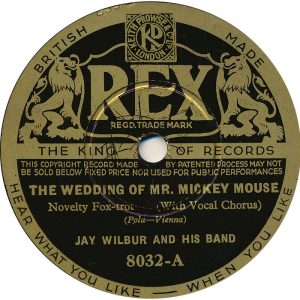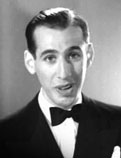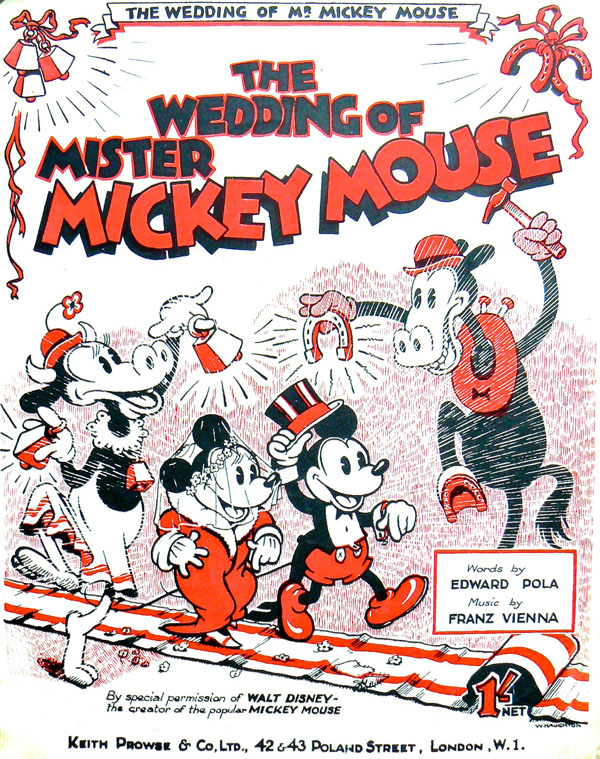 I suppose you cannot blame the songwriters and publishers in Denmark Street for trying.
I suppose you cannot blame the songwriters and publishers in Denmark Street for trying.
After The Wedding Party of Mickey Mouse proved a disappointment when it came to sales, the denizens of Denmark street were not willing to give up on what they thought was a good idea.
And so, a year after “Wedding Party” came and went without much notice, the publisher Keith Prowse came up with what proved to be the winning formula–at least, for the British and Continental European markets.
“The Wedding of Mister Mickey Mouse” was credited to Franz Vienna (composer) and Eddie Pola (lyricist). “Franz Vienna” sounds like a pseudonym to me–but I’ve not the slightest idea as to whom that name could conceal, if it is false.
Eddie Pola had more of a career for himsef. He was an American who went over to London in the late 1920’s as part of a duet partnership with one Ted Bramdt. Pola stayed in London, wrote songs, and appeared ion stage and in films.

Eddie Pola
Unlike “Wedding Party”, this song was covered by all the major British record labels, and some of the minor ones, as well. It gave the dance-bands great latitude to include squeaks, squawks, and “novelty” effects. And various band members could either talk or sing in falsetto (doing their impression of the happy coupe), or laugh in their throats, doing impressions of the Goof–who was already getting noticed, even in 1933. The lyric even drops the names of Peg Leg Pete, Clarabelle Cow, and Pluto.
Among the bands that got to record this song were some major names in Britain (Jack Hylton, Henry Hall), some good second-line dance bands (Syd Lipton, Harry Leader), some studio combinations (Harry Bidgood), and even a regional dance band which worked out of the Tower in Blackpool (Larry Brennan).
This song seems to have enjoyed success on the other side of the Channel. AT least two French performances are known. One may be by a studio band, issued on Pathe’ as by the Novelty Dance Orchestra. The other is an Odeon disc by Bela Dajos–in reality a Belarussian pretending to be a Hungarian. His had been one of the most successful bands in Berlin in the 1920’s. But he had to join the exodus of talent from Berlin when Hitler came to power. Dajos was luckier than some–he eventually wound up in Buenos Aires during the Second World War.
The song–like the cartoons–was known even in the Germany of Hitler and company. It was treated as a light musical bon-bon, as played by violinist Barnabas von Geczy (GEH-chee), and his brassless orchestra. Von Geczy worked all through, and after, the Second World War. He was known as “The Tea-Time Paganini”.
To the best of my knowledge, “The Wedding of Mister Mickey Mouse” was not published, nor recorded, in the United States. (Had it been, a slight change in lyric might have been required, as the original lyric makes reference to the BBC–which would have been inaccessible to American listeners).
Nor does the song appear to have been revived by anybody in more recent years, either on the square or for laughs.

Next week: What follows the wedding …naturally!


 James Parten has overcome a congenital visual disability to be acknowledged as an expert on the early history of recorded sound. He has a Broadcasting Certificate (Radio Option) from Los Angeles Valley College, class of 1999. He has also been a fan of animated cartoons since childhood.
James Parten has overcome a congenital visual disability to be acknowledged as an expert on the early history of recorded sound. He has a Broadcasting Certificate (Radio Option) from Los Angeles Valley College, class of 1999. He has also been a fan of animated cartoons since childhood.












































Franz Vienna was the nom de plume (if that’s the correct word in this case) for a fellow named Franz Steininger (1906-1974). Steininger had a varied career, including runs on a show that closed in Philadelphia in 1950 (“The Lady From Paris”), and a scattering of motion picture credits. Steininger was born (and for that matter, died), in Vienna, hence the name.
Some of this is based on IMDB, so cum grano salis may be in order here. However, one source http://www.worldcat.org/identities/lccn-nb2002-13117/ specifically identifies Franz Vienna as his alter ego; it also specifically lists him in the credits for the Mickey Mouse song.